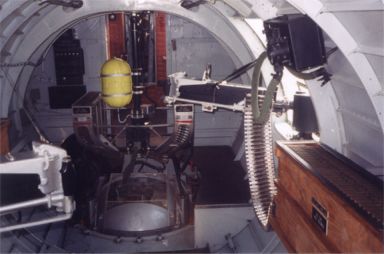Boeing B17 "Flying Fortress"
In 1934 the Army issued a call for the design of a defensive bomber capable of striking an enemy fleet. The specifications called for a "multi-engine" bomber. The Boeing entry was fitted with four engines, and put up an impressive showing against its competitors. The engines were the most advanced design of the time incorporating Superchargers. These allowed the aircraft to operate at a higher altitude, and gave it a higher speed over target. The first operational aircraft, designated B-17B, was delivered 5 years later. The B-17B had a conservative wing loading making it easy to fly, and gave it a low cruising and stall speed. However, it was not very stable if left unattended. This made emergency, in-flight egress almost impossible.

Smithsonian Mural
The Army believed that the design was advanced enough to allow the B17 to fly higher and faster than existing pursuit aircraft of the time. Intelligence emerging from Europe regarding German aircraft advances failed to raise alarms in the USAAF. The Army saw little need for self defense or armor. These attitudes changed quickly as the air war in Europe demonstrated a need for bombers to be able to defend themselves.
The next version, the B-17C, entered service in 1940; its improvements included armor, self-sealing tanks, a ventral gun emplacement and waist guns. 20 were given to the RAF and most were lost in the first week of combat. The lessons learned from the B17s combat debut were applied to the next version. The USAAF placed orders for the B-17D in 1941. The stabilizer on this model was enlarged which added greater lateral stability. These aircraft were used to develop long range, high altitude bombing missions and were first used in the Philippines. Later the same year Boeing produced the B-17E. The "E" model had a top gun, ball (belly) gun, and a tail gun. The defensive power of the B-17 impressed a LIFE reporter enough for him to label the aircraft a "Flying Fortress". The USAAF sent the "E" model into action against the Germans with the 8th Air Force in the summer of '42.
Boeing licensed production to the Douglas, and Vega (Lockheed) companies for mass production to meet demand. Between these three companies nearly 13,000 B-17s were produced by the end of the war.
The final version was the "G" model. Many minor changes had been made, but the most obvious was the chin turret which was prototyped on a few "F" models. Many also sported a gun for the radioman,
which was more of a morale boost than a defensive measure. Eventually the gun would be removed. The B-17G originally had a crew of 10 men: A pilot and co-pilot, a top gunner/engineer, bombardier,
navigator, radioman, 2 waist gunners, a ball gunner and a tail gunner. The USAAF removed the radioman's gun and reduced the crew to 9. The radioman would man a waist gun during battle. Often times
the bombardier or navigator would be left behind, since the planes in a group would drop on the cue of the lead aircraft. A nose gunner would man the chin gun and sometimes act as togglier.
In spite of the impressive array of self-defense weaponry carried by a B17, hitting a fighter was difficult at best. Nonetheless, Luftwaffe pilots had a great respect for the guns of the Flying
Fortress and were not too eager to push in closer than necessary. It is estimated that 98% of their ammo expenditures in plane to plane combat fell into open space. The reason being is the fighter
pilot's tendency to start firing at the extreme limit of their gun range to avoid the Fort's gunners. Still, losses on both sides were heavy in the early stages of the war.

Waist Area
In the photo above we are looking forward at the waist gun station of a B-17G. In the early models the waist guns were located across from one another. This made it difficult for both gunners to swing around without hitting one another. This problem was solved by staggering the waist stations. The right waist gun was moved forward.
The tail gun was replaced by the Cheyenne turret in later block B17Gs. This gave the tail gunner a wider field of fire, better aiming and a better field of view.
B-17G statistics:
- WING SPAN: 31.6m (103' 9")
- WING AREA: 131.92 square meters (1,420 square feet).
- Length: 22.8 m (74' 9")
- Weight: 1,7240 kg (38,000 lbs) empty, 29,756 kg (65,600 lbs) military load, 32,660 kg (72,000 lbs) overload.
- Engines: 4 1,200 hp Wright Cyclone R-1820-97 with turbo chargers.
- Max Speed: 462 km/h (287 mph) at 30,000 ft.
- Service ceiling: 10850 m (35,600 ft).
- Range: Max bomb load - 1,760 km (1,100 miles), Ferry - 4,830 km (3,000 miles)
- Armament: 4 twin 50 caliber, up to 6 single 50 caliber, with 500 rounds each.
The B-24 "Liberator."
A ride on the Aluminum Overcast.
A ride on the Sentimental Journey
Tour of the Thunderbird
Collings Foundation "909"
Norden Bombsight
Bomber formation
Comparisons between the B17 and the B24.
B17 pictures
Bill York's Ride
Aircraft of the 486th Bomb Group
Copyright © 1998-2024, 486th Bomb Group Association.